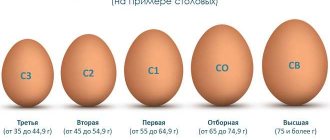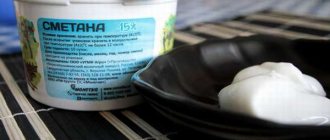However, what is surprising is that they have a shorter shelf life than fresh eggs.
This article explains how long you can store hard-boiled eggs and how to keep them fresh longer.
How long do eggs last in the refrigerator and at room temperature?
In addition to chicken eggs, quail, turkey, and goose eggs are popular among people. Less commonly used are ostrich and duck. All of them differ not only in their mass, but also in their shelf life. Therefore, advice on how to properly store, for example, quail eggs and chicken eggs, differs. So how many days can raw eggs be stored in the refrigerator after laying, and what are the requirements for boiled ones? This information is reflected in the following table.
Table - Shelf life of eggs in the refrigerator
| Type of egg | Shelf life in the refrigerator | |
| Chicken | Raw | – 7 days (for consumption raw); – 25 days (GOST); – 30 days (manufacturers’ recommendation); – 120 days (if necessary); – 2 days (broken, keep in a tightly closed container) |
| Boiled | – 5-7 days (whole); – 3-4 days (damaged) | |
| Quail | Raw | Up to 2 months (after 10 days do not eat raw) |
| Boiled | – Week (integer); – 3 days (damaged) | |
| Duck | Raw | 2 weeks (raw duck eggs are only used in baking) |
| Boiled | No more than 3 days (cook for 15 minutes) | |
| Gusinoye | Raw | No more than 14 days (do not eat raw) |
| Boiled | Up to 7 days (cook for at least 25 minutes, do not give to children under 7-8 years old) | |
| Ostrich | Raw | – 90 days (integer); –2-3 days (damaged) |
| Boiled | Up to 5 days (cooking – 1.5 hours) | |
Interestingly, chicken eggs in brown shells are stored better than white ones. According to sanitary standards, the shelf life of chicken eggs at temperatures from 0 ° C to 20 ° C in a dark place is:
- dietary – seven days,
- canteens – 25 days;
- boiled - ten hours.
In practice, this means that in winter, raw chicken and quail eggs can be stored at room temperature.
Ostriches lay eggs (weighing up to 2.2 kg) exclusively in the summer, so keeping an ostrich egg indoors is not advisable. Waterfowl eggs are also best placed in the refrigerator immediately. The porous structure of their shell allows bacteria to penetrate into the middle. Therefore, goose and duck eggs are especially susceptible to salmonellosis.
Can it be frozen?
Frozen storage is not recommended, especially whole. However, you can freeze the yolks. Some housewives believe that after being in low temperature conditions, the yolk only becomes more tender. Protein, on the contrary, after freezing loses its taste and its consistency becomes rubbery. Eggs in their shell should also not be placed in the freezer - frost causes the shell to crack and crumble.
To properly freeze yolks, you need to prepare them correctly:
- Separate from proteins.
- Boil in an enamel bowl.
- After the water boils, turn off the heat and let stand for 15 minutes.
- Remove from the water and dry, you can chop if required.
- Once cooled, pack into special freezer bags.
Features of the frozen product:
- Frozen yolks can be stored for 1 year.
- You need to defrost gradually in the refrigerator. In the heat there is a risk that the workpiece will begin to deteriorate.
- You should not add unthawed yolk to prepared dishes.
How to hold the product correctly
Do not neglect the expiration dates of eggs. Particular vigilance is needed in the heat, when the risk of catching an intestinal infection increases many times over. What else is worth paying attention to?
- Dislocation. Although absolutely all refrigerators are equipped with special compartments for eggs on the doors (probably in order to save space), modern scientists call this the worst place for storing eggs. Each time the door is opened, there is a vigorous shaking and an influx of warm air, to which the product is very sensitive. Cooks also agree, adding that shaking thins the egg whites. The best place to place the product is considered to be a compartment or drawer for vegetables and fruits.
- Loneliness. Eggs must be stored separately. This will prevent the absorption of “foreign” odors, as well as infection in case of contact with other raw products. Food containers, special mobile cells or “native” packaging are suitable. It is recommended to wrap boiled eggs in paper.
- Position. For storage, the egg is placed with the blunt side up. Then the yolk will move to the center and will not come into contact with the air layer.
- The washing up. Eggshells have a protective film invisible to the eye, provided by nature as a natural barrier against various infections. Therefore, it is not recommended to wipe, let alone wash eggs before storing. This should be done right before eating or cooking. Many people prefer to use a cooled soda solution for cleansing (a tablespoon of baking soda per liter of water). Keep in mind that washed eggs are stored in the refrigerator for no more than 10-12 days.
- Personal hygiene. After “contact” with the product, you must wash your hands with soap.
Useful tips
Simple techniques help to increase the shelf life of the white and yolk, and it is safe to use the product:
- in the store they look at the packaging date and buy only fresh products;
- before cooking, check the integrity of the shell;
- the prepared dish with poultry products is kept out of the refrigerator for no more than two hours;
- Boiled eggs are placed in thick paper bags or in a plastic container with a lid.
Dirty shells are a sign of lack of quality control at a poultry farm or farm. Pathogenic microorganisms multiply on contaminated surfaces. Penetrating through the hard cover, microbes accelerate the spoilage of products. Therefore, only clean copies are purchased.
Ways to extend deadlines
Housewives living in rural areas are not puzzled by questions about whether it is possible and whether it is necessary to store eggs without a refrigerator. Chickens in the cold season, due to the short daylight hours and winter molting, lay eggs reluctantly or even refuse to do so. Therefore, in villages it is customary to make a substantial supply of eggs for the winter. Two methods are used for this
- Lubricating the shell with beeswax. Wax is necessary to clog the pores on the shell. It creates a thin but fairly reliable protective layer. They can remain “waxy” for up to six months, while the storage temperature of domestic eggs should be 3-10 °C.
- Coating the shell with lard (melted lard). As in the first case, only eggs “from chickens” are suitable for this, with a strong shell without damage. Greased eggs are placed in boxes with ventilation holes and soft filling (sawdust, straw, finely chopped paper). Then they are transferred to the basement. An additional protective layer extends the natural shelf life of raw eggs to six months. At home, you can extend the freshness of the product by lubricating its shell not only with fat, but also with regular vegetable oil.
There is also a way to store boiled eggs for a long time. Hard-boiled specimens need to be marinated. By the way, this is a traditional dish in English cuisine.
Egg storage factors
One of the main conditions for long-term preservation of a product is its cooling. Room temperature negatively affects the quality of stored poultry products, regardless of whether they are fresh or heat-treated. The latter case is due to the fact that the product cannot remain without cooling for a long time.
An important component is the time of egg production. If it was demolished more than one month ago, it is not recommended to cook such products.
Freshness is determined by removing the shell. Easy cleansing of the surface shell indicates that the testicle is good, difficult - the opposite.
The absence of deformation on the shell will also prolong the freshness and quality of the product.
To prevent a boiled egg from spoiling for a long time, it is advisable to adhere to the following recommendations:
- Select clean eggs with intact shells.
- They must warm up to room temperature before processing. The opposite causes cracking.
- After thermal exposure, place on a dry cloth to dry.
- Have a storage container.
If the hard shell is damaged, the product is consumed after 2-4 days; room temperature reduces the period to 12 hours.
Freshness test: in water...
There are several methods to control the freshness of eggs. The most famous and elementary one is to check eggs for freshness in water. To do this, they are placed in a deep, spacious bowl, filled with water at room temperature or a saline solution (a teaspoon of salt per liter of water). The “mirror” option is to carefully lower the eggs into a container with liquid already poured.
This reliable verification method is based on the properties of the egg itself, the air chamber of which grows in size with each day of storage. Therefore, it does not sink: the moisture evaporating through more than 7 thousand pores in the shell is replaced by air, which accumulates at the blunt end of the egg. Interestingly, in this way you can even find out the degree of freshness of eggs.
- "First" freshness. The freshest eggs will remain at the bottom of the dish in a horizontal position. There is simply no free space for air in their internal space.
- “Second” freshness. Or fresh enough. Eggs, turned with the blunt edge upward and as if standing on a sharp end, are at least two to three weeks old. This is not a fresh product, but is safe for consumption after heat treatment. Actually, most store-bought eggs fall into this category, except for those marked with the letter “D” (that is, dietary, and therefore the freshest).
- Stale. Spoiled eggs float to the very surface and are prohibited from being eaten. Over a long period of storage, so much air accumulates inside the egg that putrefactive processes begin in it.
If you are in doubt about the freshness of eggs, it is better not to mix them with other foods or eggs. Use a separate bowl and break them up one at a time.
Signs by which you can understand that the yolk and white have begun to deteriorate
Spoiled egg products give off a disgusting smell. If storage rules are violated or the expiration date is exceeded, the protein changes color to dirty gray or bluish. Do not panic when you see that the boiled yolk is surrounded by a greenish-blue ring and has become hard. This is caused by exceeding the cooking time in water with a high concentration of iron. This food is safe.
Simple tests that are carried out before cooking help determine whether the product has begun to deteriorate.
A spoiled product produces a strong unpleasant odor
In water
The egg is immersed in a bowl filled with cold salted water and its location is observed:
- a fresh specimen (up to two weeks old) will sink, turn on its side at the bottom or stand on its tip;
- less fresh, but safe for health (laid down 14 - 21 days ago) will be immersed in water, but will not sink to the bottom of the dish;
- the missing will lie on the surface.
Only the first 2 types will not cause food poisoning; the third should be thrown out.
Popular egg freshness test
Transmission quality check
The egg is viewed by turning on a powerful backlight. The product is spoiled if one of the following signs is visible under the shell:
- blood clot(s);
- embryo;
- blood ring;
- large dark stains;
- a large air pocket between the shell and the white.
In fresh samples, the white is pure, without inclusions, the yolk occupies the central part. Later, small dark spots appear in the white.
Good to know, read: - 19 folk ways to remove smell from the refrigerator: what to wash with and what to put inside.
Other methods
The following techniques can also help check freshness:
- if you shake a stale specimen next to your ear, you will hear a strange sound, similar to squelching, and it will seem that the protein is shaking; there is no sound when shaking a fresh sample;
- the outer shell of a fresh egg is matte and rough to the touch; in a rotten sample, it has dark spots, is soft and shiny.
Additional Information! Testicles laid 7 to 14 days ago are easily cleaned. Near the blunt end, under the shell, there is an air sac. The size of this pocket depends on the age of the testicle: the younger the age, the smaller the size. In mature ones, the liquid component decreases, and the size of the air pocket becomes larger. After cooking and cooling, steam appears there, separating the white from the shell. When fresh, the bag is small and there is not enough space for steam to form. Cooked egg whites stick to the outer shell, making these eggs difficult to peel.
...with the help of light
The candling method, or candling, is widely popular among farmers who use a special ovoscope device for this purpose. To test at home, you will need very bright light and a dark room. If in the old days this was done with a candle, today you can use a strong lamp or a powerful flashlight.
To assess the presence or size of an air “cushion” inside the egg, you will need to do a little tinkering, because the diameter of the light beam should be less than the diameter of the egg itself. To do this, cover a 60-75 W lamp or a very bright flashlight with a piece of cardboard with a hole 2.5 cm in diameter. Then you need to “put” an egg on the beam of light and begin to study its contents. The larger the air gap at the blunt end, the older the egg.
At first glance, this method seems complicated, but with a little practice you can easily determine the freshness of the eggs, as well as see the contours of the yolk and the presence of blood clots (signs of fertilization).
... and additional manipulations
There are other ways to determine the freshness of an egg. For example, measuring temperature in different parts of it or ultraviolet scanning. But they are rather from the realm of complex experiments. But the following four methods are quite suitable for independent “revision”.
- Shake. The good thing about this method is that it can be used without leaving the counter. You need to bring the egg to your ear and shake it. “Chatterbox”, unsuitable for consumption, is characterized by “squelching”. The explanation is simple - during prolonged storage, the inner membrane moves away from the shell, the contents of the egg dry out and begin to dangle. The absence of extraneous sounds is an indicator of freshness.
- Smash. You will need a flat plate into which the egg is broken and the condition of its contents is assessed. A fresh egg has a yolk that is convex, round, and holds its shape, and the white is viscous and dense. A flat yolk and a watery, runny white indicate an “aged” egg.
- Clear. Boiled fresh eggs have one drawback: they are not easy to peel. The shell comes off unevenly, along with part of the protein. Fresh peeled eggs look unsightly and are not suitable for decorative purposes. A boiled, sitting egg is easy to peel and smooth. At its end, where there was air, after cooking there is always a characteristic depression.
- Smell. To check if an egg is rotten, just smell it. The specific rotten “smell” is the smell of hydrogen sulfide, a gas that appears due to the rotting of protein. The nose will unmistakably identify a hopelessly spoiled product.
By smell you can also check the freshness of boiled eggs, which have a shorter shelf life than fresh ones. Their shells are porous, which means they are even more vulnerable to air and bacteria. In reviews, some housewives advise freezing pre-peeled eggs. But professional chefs do not recommend doing this, since freezing destroys their cellular structure, the protein turns into “rubber” after thawing, and the shelf life of the product, on the contrary, decreases.
If the shelf life of eggs is in doubt, it is better to avoid eating them raw, as well as barely fried fried eggs, soft-boiled dishes and scrambling - a Scottish “scrambled” omelette. By the way, the modern menu of many foreign restaurants contains information about the presence of raw or undercooked eggs in dishes, which is associated with the fear of visitors of becoming infected with salmonellosis.
Video on the topic
Reviews
It's all poo-poo-ha! Eggs can be stored without a refrigerator, in a dark place, if possible, in a draft. A normal, FRESH egg can lie at room temperature for about a week - believe me, a villager who has chickens. By the way, an egg may simply freeze near the back wall of the refrigerator, then thaw and you will have to wash the shelf.
Alexander, https://takprosto.cc/kak-hranit-yayca/
Yes, it seems that the time has passed when they took eggs in stock in trays... you can’t keep up with the prices, and eating expired eggs is only to your own detriment, that’s why I don’t buy eggs in large quantities, and besides, when buying, I pay attention to the labeling, which indicates expiration date . The situation is approximately the same with quail eggs; I don’t take more than a dozen. I often see that people buy cheaper cracked eggs or the so-called “battle”, I don’t take the risk, unless it’s something to put in baked goods. You won’t be able to save much, but you can create health problems for yourself. Living by this principle, there are no problems with storing eggs in the refrigerator... I ran out of eggs, went and bought a dozen more... Zoya, https://postirke.ru/xranenie/crok-xraneniya-yaic-v-xolodilnike.html
Peculiarities
eggs in the refrigerator compartment in a container, glass or plastic, hermetically sealed .
You can also put them on the shelf in the cardboard container in which the products are sold in stores.
It is better if the storage is closed with a lid. This way the eggs will not absorb foreign odors that hang around in the refrigerator. This will also prevent unpleasant odors from spreading across the shelves if poultry products begin to spoil.











